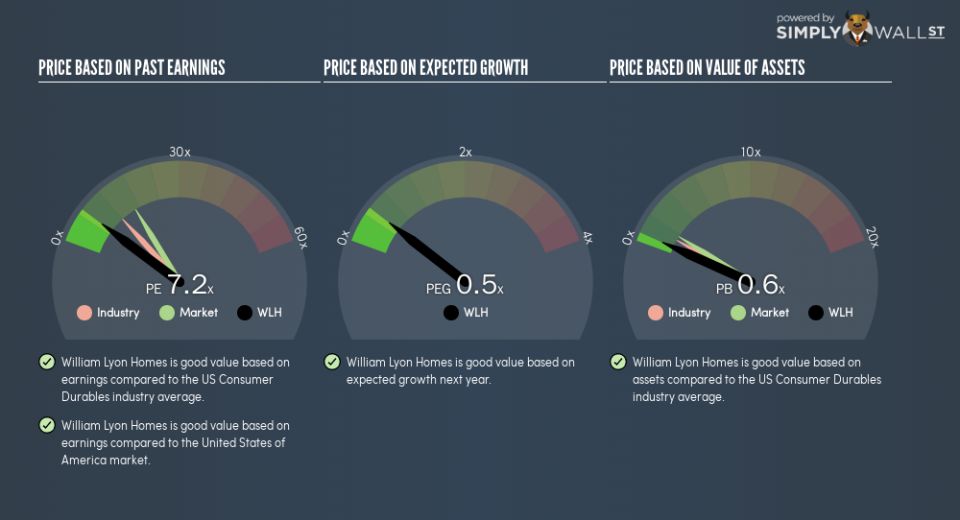Do You Like William Lyon Homes (NYSE:WLH) At This P/E Ratio?

Want to participate in a short research study? Help shape the future of investing tools and receive a $60 prize!
This article is written for those who want to get better at using price to earnings ratios (P/E ratios). To keep it practical, we’ll show how William Lyon Homes’s (NYSE:WLH) P/E ratio could help you assess the value on offer. Based on the last twelve months, William Lyon Homes’s P/E ratio is 7.24. That is equivalent to an earnings yield of about 14%.
See our latest analysis for William Lyon Homes
How Do You Calculate A P/E Ratio?
The formula for P/E is:
Price to Earnings Ratio = Price per Share ÷ Earnings per Share (EPS)
Or for William Lyon Homes:
P/E of 7.24 = $13.26 ÷ $1.83 (Based on the year to September 2018.)
Is A High Price-to-Earnings Ratio Good?
A higher P/E ratio implies that investors pay a higher price for the earning power of the business. That is not a good or a bad thing per se, but a high P/E does imply buyers are optimistic about the future.
How Growth Rates Impact P/E Ratios
Probably the most important factor in determining what P/E a company trades on is the earnings growth. When earnings grow, the ‘E’ increases, over time. Therefore, even if you pay a high multiple of earnings now, that multiple will become lower in the future. A lower P/E should indicate the stock is cheap relative to others — and that may attract buyers.
Most would be impressed by William Lyon Homes earnings growth of 14% in the last year. And earnings per share have improved by 4.3% annually, over the last three years. So one might expect an above average P/E ratio. Unfortunately, earnings per share are down 20% a year, over 5 years.
How Does William Lyon Homes’s P/E Ratio Compare To Its Peers?
The P/E ratio essentially measures market expectations of a company. If you look at the image below, you can see William Lyon Homes has a lower P/E than the average (12.1) in the consumer durables industry classification.
This suggests that market participants think William Lyon Homes will underperform other companies in its industry. Many investors like to buy stocks when the market is pessimistic about their prospects. You should delve deeper. I like to check if company insiders have been buying or selling.
Remember: P/E Ratios Don’t Consider The Balance Sheet
The ‘Price’ in P/E reflects the market capitalization of the company. Thus, the metric does not reflect cash or debt held by the company. Theoretically, a business can improve its earnings (and produce a lower P/E in the future), by taking on debt (or spending its remaining cash).
Such expenditure might be good or bad, in the long term, but the point here is that the balance sheet is not reflected by this ratio.
Is Debt Impacting William Lyon Homes’s P/E?
William Lyon Homes’s net debt is considerable, at 296% of its market cap. If you want to compare its P/E ratio to other companies, you must keep in mind that these debt levels would usually warrant a relatively low P/E.
The Verdict On William Lyon Homes’s P/E Ratio
William Lyon Homes has a P/E of 7.2. That’s below the average in the US market, which is 16.7. While the EPS growth last year was strong, the significant debt levels reduce the number of options available to management. If the company can continue to grow earnings, then the current P/E may be unjustifiably low.
Investors should be looking to buy stocks that the market is wrong about. As value investor Benjamin Graham famously said, ‘In the short run, the market is a voting machine but in the long run, it is a weighing machine.’ So this free visualization of the analyst consensus on future earnings could help you make the right decision about whether to buy, sell, or hold.
You might be able to find a better buy than William Lyon Homes. If you want a selection of possible winners, check out this free list of interesting companies that trade on a P/E below 20 (but have proven they can grow earnings).
To help readers see past the short term volatility of the financial market, we aim to bring you a long-term focused research analysis purely driven by fundamental data. Note that our analysis does not factor in the latest price-sensitive company announcements.
The author is an independent contributor and at the time of publication had no position in the stocks mentioned. For errors that warrant correction please contact the editor at editorial-team@simplywallst.com.

 Yahoo Finance
Yahoo Finance 
